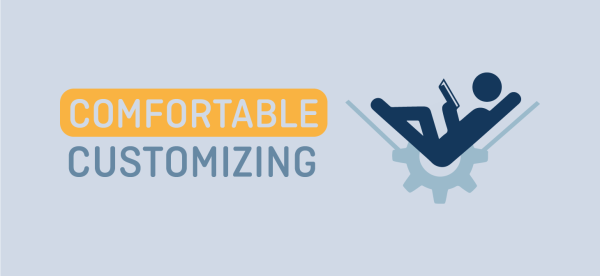Comfortable Customizing
The Future of Specialty Lenses
By Eef van der Worp
Never a dull moment in our industry. Although this past period will surely be remembered as ‘the COVID era’, there are so many new and exciting developments going on that maybe in the future, all of these technological advances may outweigh the negative vibes of COVID for our industry.
Customizing for Myopia
By far, the most potential in our field is in ‘upgrading’ myopia correction efficacy. Historically, we have always used standard ortho-k lens designs. But we can do better than that, it seems, and it has become increasingly obvious that with so many variables, it is hard to even get started on that without being dazzled. Let me try, though.
The optics of the eye are more complex than many of us realise. For one, the aberrations of the eye change with age. Young children, kids in elementary school and young teens all have different aberration patterns. The higher-order optics of the eye change with pupil size too. Taking all of that into account can surely enhance and optimize the orthokeratology outcome. But it gets even more exciting if we go for the ‘full business class upgrade’ by measuring and applying individual aberration patterns. Everybody is different, and in fact, every eye is different. Understanding this and incorporating it into an individual lens for a specific patient may prove to be very efficacious.
A fascinating review paper by Rohan Huges and the research team at Queensland University of Technology in Brisbane (AU) states that HOAs are optical imperfections of the eye that alter retinal image quality despite optimal correction of spherical defocus and astigmatism. Because HOAs reduce retinal image quality and produce variations in optical vergence across the entrance pupil of the eye, they may provide optical signals that contribute to the regulation and modulation of eye growth and refractive error development. The magnitude and type of HOAs vary with age and refractive error and during near work and accommodation. Furthermore, distinctive changes in HOAs occur with various correction modalities, including, near addition spectacle lenses, ortho-k and soft multifocal and dual-focus contact lenses. In other words, there is work to do, but there surely is potential.
Customizing Corneals & Sclerals
If we look just at what eye care practitioners (ECPs) in my country (the Netherlands) do: by far, the majority of corneal GP lenses are not fitted with a trial set anymore. Sometimes it is still nice to have a trial lens available, to get a quick idea of the potential gain in visual acuity (especially on more challenging corneas). But from a fitting process point of view, the algorithms that the large manufacturers use to generate a lens based on corneal topography are so advanced, that only a very seasoned and experienced lens fitter with a lifetime of practical years under his or her belt could match that. But even then, it may be hard to beat the algorithm, let alone for a new ECP just coming out of school. This is a good thing: it means we are not fully reliant on the human factor anymore to fit corneal GPs going forward.
The advancement that scleral lens back surface designs have made in the last year or so has been amazing to watch. Early studies at Pacific University (US) already noted that the scleral surface on the anterior eye isn’t spherical at all – and that it increases in irregularity further out to the periphery. But now with two state-of-the-art profilometry instruments and the latest Scheimpflug instrument upgraded to measure scleral shape, toric and more complex scleral lens designs are now becoming the standard.
There are various ways to fit these: you can use the scleral topography data to design the rotationally asymmetric scleral lens yourself using software, you can have the instrument with the incorporated software do the trick, or you could send the scleral topography file to the manufacturer to be processed and transformed into a lens – or a combination of the above. In addition, there is the impression-moulding technique for sclerals as the ultimate customized solution, if needed. All of this means, as with corneal GPs, that customization is becoming the norm with scleral lens designs.
Customizing Soft
Of all the specialty lenses, soft customized lenses may actually have the biggest potential. For starters: the bulk of all contact lenses fitted internationally are soft lenses – 86% according to the latest Eurolens Research Survey data. And – funny enough – we don’t fully understand this modality.
Recent studies have shown what the normal eye looks like over a larger diameter (covering the area where a soft lens lands), while at the same time, more information about the overall sagittal height of the lenses that we fit daily has become available. Work by Graeme Young et al confirmed that soft lenses need to be fitted ‘somewhat steeper’ than the ocular surface in order to gain the desired ‘grip’ on the eye. In our terminology, we call this the δ-sag (delta-sag): the difference between the sagittal height of the ocular surface over a given area and the contact lens sagittal height, so the lens needs to bend or deflect to do so.
This finally gives us more control over actually ‘fitting’ soft lenses again. But it also shows that any given soft lens on the eye has to bend or flex, to conform to the shape of the eye. The term used for this is the deflection factor. How much exactly is still up for debate, and in current lens wearers, this value varies quite a lot. This also means that the deflection in some lenses may be 100 microns, while in others it could be several hundreds of microns. What does that do to the optics of a lens? We don’t know that. In a standard -3.00D spherical lens design, it probably will not generate more than 0.25D change. But in more complex lens designs – e.g., toric or multifocal, this could prove to be more than trivial.
Understanding this, and then applying that to soft lenses – taking the individual and general characteristics regarding age and pupil size into account – could potentially have a huge impact.
Educational Series & the Future
The educational grant over 2021, kindly supported by Contamac, has allowed me to provide generic specialty lens education for a better understanding of what we are actually doing with all these different specialty lens modalities and to potentially take advantage of all of the possibilities available to us.
Topics over the past year included mostly scleral lenses, corneal topography, scleral topography, soft lens fitting and myopia management. But what all of these have in common is the generalised potential to customize lenses and to take (more) advantage of the individual needs of the patient – whatever they may be.
The future looks bright for specialty lenses in my view. We just have to get a little bit more comfortable with customizing. I think we ‘get it’ now as an industry to a large degree when it comes to aligning the lens with the eye and respecting the ocular surface with various lens modalities. ‘Next up’ is understanding and applying optimal and advanced contact lens optics. Stay tuned. Even 3D printing options are being explored seriously now.
Thank you to Eef van der Worp for contributing to Global Insight.
References:
Alam et al – 3D Printed Contact Lenses – ACS Biomaterial Sci Eng – July 2021
Hughes et al – Higher order aberrations, refractive error development and myopia control: a review – Clin Exp Optom – January 2020
Janssen F – Size does matter – Contact Lens Inside (Dutch Contact Lens association contact lens magazine) – December 2021
Morgan P et al – International Contact Lens Prescribing 2021 – Contact Lens Spectrum – January 2022
Tomiyama et al Greater higher order aberrations induced by toric orthokeratology versus soft toric multifocal contact lens wear – Ophthalmic & Physiological Optics – June 2021
Van der Worp – Variation in sag values in daily disposable, reusable and toric soft contact lenses in the journal – Contact Lens and Anterior Eye – December 2021

Eef van der Worp is an educator and researcher. He received his optometry degree from the Hogeschool van Utrecht in the Netherlands (NL) and has served as a head of the contact lens department at the school for over eight years. Eef received his PhD from the University of Maastricht (NL) in 2008. He now runs his own research & education consultancy ‘Eye-Contact-Lens’ which is based in Amsterdam (NL). He is a fellow of the AAO, BCLA and the SLS, a lifetime fellow of IACLE and an honorary life member of ANVC. He is on the education committee for the GSLS and the OVN. Eef is adjunct assistant Professor at Pacific University College of Optometry (Oregon, USA), and adjunct Professor at the University of Montreal University College of Optometry (CA) and he is lecturing extensively worldwide and is a guest lecturer at a number of Universities in the US and Europe.
More by Eef van der Worp:

